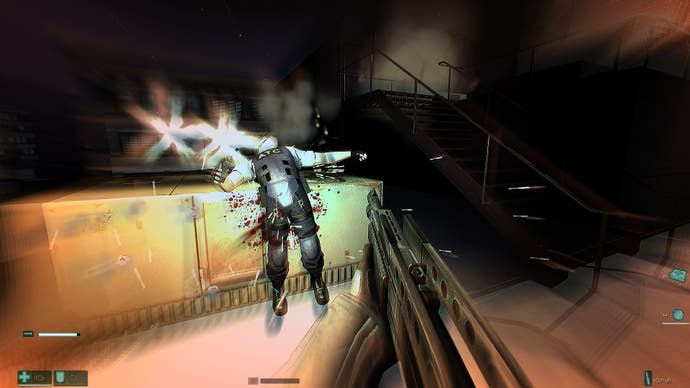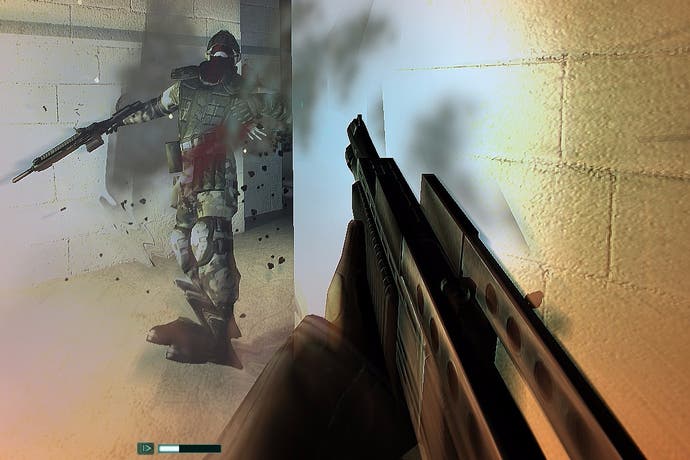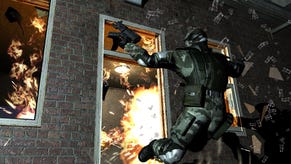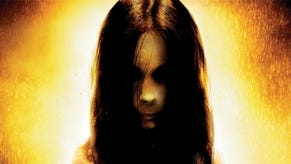Gaming's greatest shotgun, and the FPS that made Monolith what it is today
Shotgun wedding.
F.E.A.R has the best goddamn shotgun in the history of gaming. This is a hotly competed category, including strong entrants from the likes of Doom and Half-Life - and I'm sure you'll all point to a dozen more once my words run dry. But for my money, F.E.A.R's shotgun is gaming's finest interpretation of clicking a button to make a man die.
It doesn't look particularly special. It's a plain black tube that lurks malevolently at the bottom of your screen like a YouTube comment. But that all changes when you pull the trigger. Everything from the sound of it to the weight of it to the force it projects into the game world is so wonderfully over the top - and that effect is doubled in F.E.A.R's super syrupy slow-motion. The boom of each shell becomes an underwater explosion as the muzzle flare illuminates the room. The unfortunate soldier-clone you've just blasted flies back into the scenery, bullets spraying from their own weapon as they tumble to their death. Sometimes they'll lose a head or an arm in the process. Other times they'll just burst like a meat balloon.
F.E.A.R's shotgun embodies everything F.E.A.R is built to do in a three-second feedback loop that can propel you through the entire game. Monolith has always understood that a great shooter is built from the guns outward, that all the clever mechanical gimmickry and lavish environment design won't save your game if the player's arsenal is wetter than cucumber soup. But F.E.A.R goes one step further. Everything in the game is designed to feed back into that moment where the mouse button clicks and the virtual lead starts flying.

Take the level design, for example. From an artistic perspective, F.E.A.R's environments are terrible. The story takes you from a nondescript warehouse to a nondescript office complex to a nondescript city district, all of which comprise of square rooms and angular corridors with little in the way of decoration. Compared to contemporaries Half-Life 2 and Far Cry, it's about as interesting as a two-hour lecture on Microsoft Excel presented by Michael Owen.
That all changes when the fighting begins. Gunshots carve huge holes into concrete walls and tile floors, kicking up thick clouds of dust that obscure the player's view. Glass panes shatter into thousands of pieces when a bullet or a body is propelled through them. Sparks shower from metal railings and surfaces, while forks of electricity lash out from broken computer monitors and other electrical equipment. When your first fight in F.E.A.R ends, you realise that your surroundings are drab by design. They act as a blank canvas onto which the player paints destruction - think Splatoon with a splash of added misanthropy.
The level design is subtly clever in other ways too. There are no curves in F.E.A.R. Every room and corridor is a square or a rectangle, every turn you make is 90 degrees. This is because it makes it easier for F.E.A.R's AI to find its way around. Much has been made of F.E.A.R's AI in the past, but what's truly remarkable about it is how simple and elegant its system really is.
As F.E.A.R's AI designer Jeff Orkin points out in his paper 'Three States and a Plan', "All A.I. ever do is move around and play animations." The key difference between F.E.A.R's AI and what had gone before is that the AI system doesn't tell the character which animations to play in every given situation. Instead, the AI is given a series of goals, which are layered in terms of priorities. So for example, the AI's basic goal is to shoot at the player when they seem them. But above this are several higher-level goals that take priority under different circumstances.

If the players gets too close, for example, the AI will switch from the shooting animation to the melee attack animation, whereas if the player throws a grenade, the AI's goal will switch from shooting to taking cover. At the highest level, the AI will do things like relocating if it feels its cover is compromised, and attempt to set up an ambush by moving to a designated ambush node in the level.
It's all clever stuff, but the most important aspect of the system is how Monolith explicates this decision-making to the player. Good video-game A.I is often in the eye of the beholder. Whenever a F.E.A.R clone makes a decision, they call out that decision in a way that sounds like a tactical command. It sounds like they're communicating with each other, but in reality they're demonstrating to the player their own decision-making ability. This is also why F.E.A.R's combat arenas are these orderly overlaps of rooms and corridors, not just so that the AI can navigate them easily, but so that the player can see them doing it.
In turn, this plays back into F.E.A.R's lovingly designed arsenal. Monolith wanted these fights to feel dynamic, to be playable action sequences with the emphasis on playable. Because F.E.A.R's AI is based around goals and planning, they always react in a slightly different way. They're not unpredictable, because their decisions are rooted in a clear logical hierarchy, but crucially they are decisions rather than commands.
This makes it all the more satisfying when one of them tries to sneak up behind you and is greeted by the business end of your shotgun, because you know that they'd made a genuine effort to outmanoeuvre you. Even today, F.E.A.R's AI still has the capacity to surprise. On my play-through for this piece, I saw a clone crawl underneath a stack of metal shelves that had fallen across a pathway, a behaviour that I'd never witnessed before. Again, it boils down to a different animation, but it still felt like the cheeky git was trying to out-think me.
Not every aspect of F.E.A.R is so successful. As well as being an action game, F.E.A.R has one foot in the horror genre, and more specifically a certain strand of Japanese horror as seen in the likes of The Ring and Dark Water. Personally though, I find F.E.A.R about as scary as an episode of Scooby Doo. There are a couple of half-decent jumpy bits, particularly one revolving around a ladder. But all the grisly horror imagery and Alma's human-shredding telekinetic powers are rendered moot by two things. Firstly, Alma can't actually hurt you, and second, anything that can hurt you first has to come between you and the shotgun designed by God.

F.E.A.R also struggles anytime it attempts to go beyond fighting the standard clones. Most of the other enemies, which include mechs, drones, and weird spirit things, are no fun to fight. The storytelling, meanwhile, is best described as "ambitious for its time". F.E.A.R has a decent, if very silly plot, and the way it's told through cryptic flashbacks and phone voicemails was better than having it dumped through exposition. Unfortunately, the whole thing has all the character of skimmed milk, and it takes itself incredibly seriously. The only time it comes close to cracking a smile is in the character Norton Mapes, and it's the same smile a person wears to mask their embarrassment when they let out a wet fart.
Luckily, none of this really matters, because that core loop of running into a room filled with clones, redecorating it with bullet-holes and body-parts, and then moving on to the next room is so darned satisfying. F.E.A.R made Monolith the studio it is today. It represented a dramatic shift in tone from the pulpy, tongue-in-cheek humour of SHOGO and No-One Lives Forever to a darker, more serious style that carried through Condemned into the Middle-Earth games the studio has worked on in the last few years. It also saw Monolith double-down on its cinematic inspirations, influencing not just the game's theme, but its entire concept from the core-systems up.
Today, I find myself in two minds about this. I can go back to F.E.A.R again and again, but it's a journey I make purely for that dynamic duo of shotgun and clone. The other stuff, the grimdark tone and the convoluted sci-fi plot, feel played out, and I'd like to see more of the old Monolith return. Imagine, for a moment, a game that contained all of Monolith's best bits, the AI of F.E.A.R, the personality of No One Lives Forever, and the emergent systems of Shadow of Mordor. I think I'd just about give anything for that, even, perhaps, the best shotgun in gaming.




